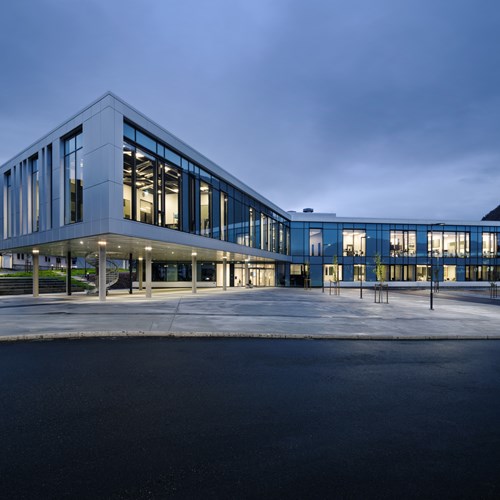
To view the content, please enable marketing cookies by clicking on the button below.
Cookie settings

Fotograf: Marius Beck Dahle
The media building was designed by LINK Arkitektur and completed in 2021. Volda University College has around 500 media students, split between six different bachelor programmes. This represents a real boost for education and the future, as media plays an increasingly important role in society. The building’s clear environmental focus is reflected in the choice of material for the exterior cladding – recycled Hydro CIRCAL aluminium – which has one of the lowest carbon footprints on the market.
Most of us would agree that it is important to have good teaching facilities that promote motivation and well-being. Schools are continuously being built and renovated. Understanding the importance of materials selection is increasingly important. This is a critical factor in efforts to reduce carbon emissions for every construction project. It is also a responsibility that is shared by everyone in the construction industry.
One important fact to remember is that there is a difference in carbon emissions between recycled aluminium from process scrap and recycled aluminium from older buildings, and this has a key impact on the total carbon footprint of a project.
The media building in Volda has high ceilings and large areas of glazing that create an open impression with lots of light and open views through the building. The building has a clear message: It is designed to be a space where students find the perfect environment for learning and well-being. In addition to this goal of the architect and developer, the choice of materials is also an important factor for an environmentally friendly building that considers the future of the next generation by re-using resources.
The glazed walls of the new media building are constructed from Sapa Facade 4150 made from Hydro CIRCAL aluminium alloy. Hydro CIRCAL is a range of prime quality aluminium made with a minimum of 75 percent recycled aluminium from post-consumer scrap, such as facades and windows that have been removed from buildings and fully recycled. One of the goals for Mediehuset at Volda was to achieve at least a 30 percent reduction in greenhouse gas emissions in comparison with a reference building that complies with current TEK requirements.
“The more projects that are built using sustainable aluminium solutions, the more we can continually improve the environmental balance between materials and construction. By using environmental product declarations and the like, our partners can always feel confident in their choices,” says Johan Strand, Sales Manager for Sapa at Hydro Building Systems.
Alloys based on recycled aluminium are now the standard solution for Sapa facades, and from 2022 they will also be the standard for windows and doors.
A college for the future
The media building makes an important statement in a region that puts great value on teaching and learning. Students are welcomed by an impressive and flexible 3,900-square-metre building that offers the highest standards of comfort in sound, lighting and air quality.
“The media professions are undergoing rapid change. The new building gives us opportunities for future-oriented teaching and research in vocational media subjects,” commented dean Audhild Gregorisdotter Rotevatn in an earlier press release.
Developer: Statsbygg
Main contractor: PEAB K. Nordang AS
Architect: LINK Arkitektur AS
Fabricator: H-fasader AS
Products:
Doors: Sapa 2086
Windows: Sapa 1086
Facades: Sapa 4150
Roof glazing: Sapa 5050